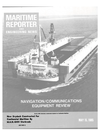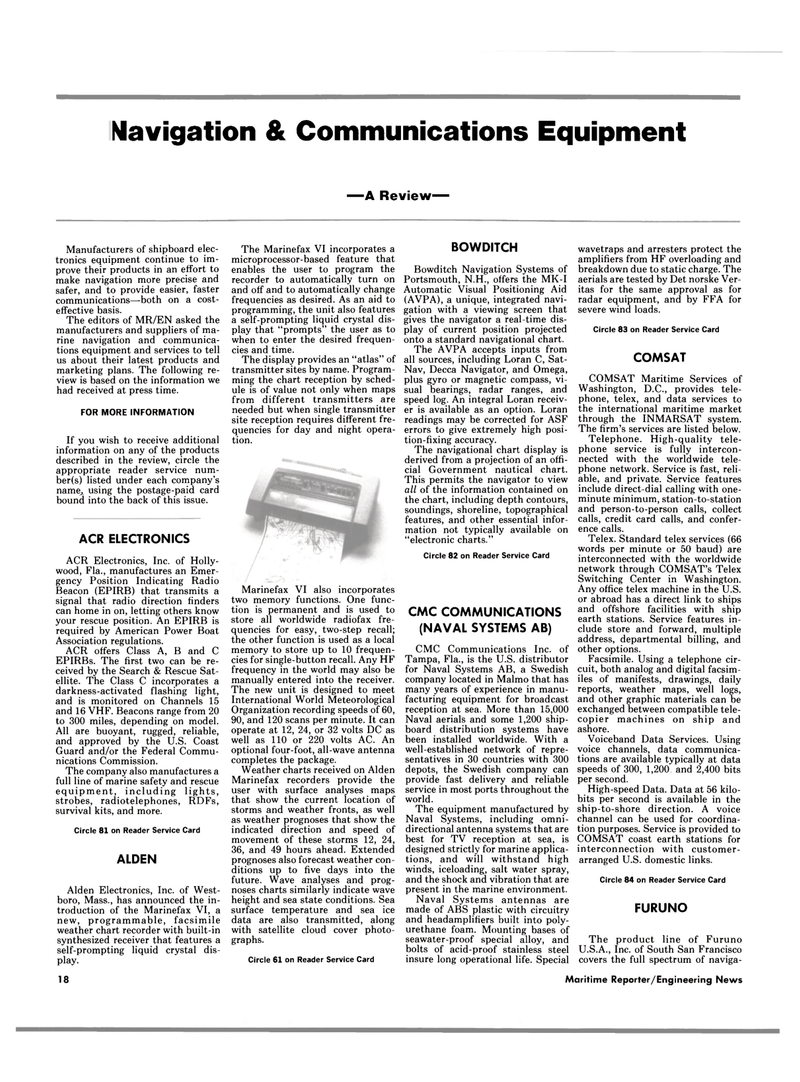
Page 16: of Maritime Reporter Magazine (May 15, 1985)
Read this page in Pdf, Flash or Html5 edition of May 15, 1985 Maritime Reporter Magazine
Navigation & Communications Equipment —A Review—
Manufacturers of shipboard elec- tronics equipment continue to im- prove their products in an effort to make navigation more precise and safer, and to provide easier, faster communications—both on a cost- effective basis.
The editors of MR/EN asked the manufacturers and suppliers of ma- rine navigation and communica- tions equipment and services to tell us about their latest products and marketing plans. The following re- view is based on the information we had received at press time.
FOR MORE INFORMATION
If you wish to receive additional information on any of the products described in the review, circle the appropriate reader service num- bers) listed under each company's name, using the postage-paid card bound into the back of this issue.
ACR ELECTRONICS
ACR Electronics, Inc. of Holly- wood, Fla., manufactures an Emer- gency Position Indicating Radio
Beacon (EPIRB) that transmits a signal that radio direction finders can home in on, letting others know your rescue position. An EPIRB is required by American Power Boat
Association regulations.
ACR offers Class A, B and C
EPIRBs. The first two can be re- ceived by the Search & Rescue Sat- ellite. The Class C incorporates a darkness-activated flashing light, and is monitored on Channels 15 and 16 VHF. Beacons range from 20 to 300 miles, depending on model.
All are buoyant, rugged, reliable, and approved by the U.S. Coast
Guard and/or the Federal Commu- nications Commission.
The company also manufactures a full line of marine safety and rescue equipment, including lights, strobes, radiotelephones, RDFs, survival kits, and more.
Circle 81 on Reader Service Card
ALDEN
Alden Electronics, Inc. of West- boro, Mass., has announced the in- troduction of the Marinefax VI, a new, programmable, facsimile weather chart recorder with built-in synthesized receiver that features a self-prompting liquid crystal dis- play.
The Marinefax VI incorporates a microprocessor-based feature that enables the user to program the recorder to automatically turn on and off and to automatically change frequencies as desired. As an aid to programming, the unit also features a self-prompting liquid crystal dis- play that "prompts" the user as to when to enter the desired frequen- cies and time.
The display provides an "atlas" of transmitter sites by name. Program- ming the chart reception by sched- ule is of value not only when maps from different transmitters are needed but when single transmitter site reception requires different fre- quencies for day and night opera- tion.
Marinefax VI also incorporates two memory functions. One func- tion is permanent and is used to store all worldwide radiofax fre- quencies for easy, two-step recall; the other function is used as a local memory to store up to 10 frequen- cies for single-button recall. Any HF frequency in the world may also be manually entered into the receiver.
The new unit is designed to meet
International World Meteorological
Organization recording speeds of 60, 90, and 120 scans per minute. It can operate at 12, 24, or 32 volts DC as well as 110 or 220 volts AC. An optional four-foot, all-wave antenna completes the package.
Weather charts received on Alden
Marinefax recorders provide the user with surface analyses maps that show the current location of storms and weather fronts, as well as weather prognoses that show the indicated direction and speed of movement of these storms 12, 24, 36, and 49 hours ahead. Extended prognoses also forecast weather con- ditions up to five days into the future. Wave analyses and prog- noses charts similarly indicate wave height and sea state conditions. Sea surface temperature and sea ice data are also transmitted, along with satellite cloud cover photo- graphs.
Circle 61 on Reader Service Card
BOWDITCH
Bowditch Navigation Systems of
Portsmouth, N.H., offers the MK-I
Automatic Visual Positioning Aid (AVPA), a unique, integrated navi- gation with a viewing screen that gives the navigator a real-time dis- play of current position projected onto a standard navigational chart.
The AVPA accepts inputs from all sources, including Loran C, Sat-
Nav, Decca Navigator, and Omega, plus gyro or magnetic compass, vi- sual bearings, radar ranges, and speed log. An integral Loran receiv- er is available as an option. Loran readings may be corrected for ASF errors to give extremely high posi- tion-fixing accuracy.
The navigational chart display is derived from a projection of an offi- cial Government nautical chart.
This permits the navigator to view all of the information contained on the chart, including depth contours, soundings, shoreline, topographical features, and other essential infor- mation not typically available on "electronic charts."
Circle 82 on Reader Service Card
CMC COMMUNICATIONS (NAVAL SYSTEMS AB)
CMC Communications Inc. of
Tampa, Fla., is the U.S. distributor for Naval Systems AB, a Swedish company located in Malmo that has many years of experience in manu- facturing equipment for broadcast reception at sea. More than 15,000
Naval aerials and some 1,200 ship- board distribution systems have been installed worldwide. With a well-established network of repre- sentatives in 30 countries with 300 depots, the Swedish company can provide fast delivery and reliable service in most ports throughout the world.
The equipment manufactured by
Naval Systems, including omni- directional antenna systems that are best for TV reception at sea, is designed strictly for marine applica- tions, and will withstand high winds, iceloading, salt water spray, and the shock and vibration that are present in the marine environment.
Naval Systems antennas are made of ABS plastic with circuitry and headamplifiers built into poly- urethane foam. Mounting bases of seawater-proof special alloy, and bolts of acid-proof stainless steel insure long operational life. Special wavetraps and arresters protect the amplifiers from HF overloading and breakdown due to static charge. The aerials are tested by Det norske Ver- itas for the same approval as for radar equipment, and by FFA for severe wind loads.
Circle 83 on Reader Service Card
COMSAT
COMSAT Maritime Services of
Washington, D.C., provides tele- phone, telex, and data services to the international maritime market through the INMARSAT system.
The firm's services are listed below.
Telephone. High-quality tele- phone service is fully intercon- nected with the worldwide tele- phone network. Service is fast, reli- able, and private. Service features include direct-dial calling with one- minute minimum, station-to-station and person-to-person calls, collect calls, credit card calls, and confer- ence calls.
Telex. Standard telex services (66 words per minute or 50 baud) are interconnected with the worldwide network through COMSAT's Telex
Switching Center in Washington.
Any office telex machine in the U.S. or abroad has a direct link to ships and offshore facilities with ship earth stations. Service features in- clude store and forward, multiple address, departmental billing, and other options.
Facsimile. Using a telephone cir- cuit, both analog and digital facsim- iles of manifests, drawings, daily reports, weather maps, well logs, and other graphic materials can be exchanged between compatible tele- copier machines on ship and ashore.
Voiceband Data Services. Using voice channels, data communica- tions are available typically at data speeds of 300, 1,200* and 2,400 bits per second.
High-speed Data. Data at 56 kilo- bits per second is available in the ship-to-shore direction. A voice channel can be used for coordina- tion purposes. Service is provided to
COMSAT coast earth stations for interconnection with customer- arranged U.S. domestic links.
Circle 84 on Reader Service Card
FURUNO
The product line of Furuno
U.S.A., Inc. of South San Francisco covers the full spectrum of naviga- 18 Maritime Reporter/Engineering News

 15
15

 17
17
